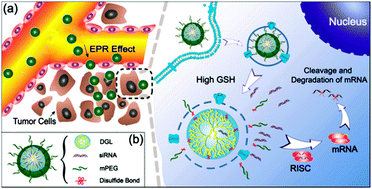Harnessing the PEG-cleavable strategy to balance cytotoxicity, intracellular release and the therapeutic effect of dendrigraft poly-l-lysine for cancer gene therapy
Abstract
Dendrimer catiomers like dendrigraft poly-L-lysine (DGL) have been very popular vectors for gene delivery recently; however, they generally suffer from serious cytotoxicity for high density of positive charge. PEGylated DGL engineered using the PEG cleavable mechanism (DGL(R)-SS-mPEG) was first developed as a non-viral gene vector for cancer intervention. Cleavable PEGylation of the DGL catiomer in tumor relevant glutathione (GSH) conditions enables us to dramatically decrease the cytotoxicity as well as to promote the intracellular release and expression of the genetic payload. Like DGL, DGL(R)-SS-mPEG is capable of efficiently complexing with plasmid DNA (pDNA) to afford homogeneous compact nano-complexes. Those gene carrying nanostructures could be stably dispersed in the regular serum medium without GSH, but with fast PEG dis-assembly if subject to 10 mM GSH. Compared with the non-cleavable counterpart, PEG-cleavable dendrigraft poly-L-lysine exhibited significantly higher enhanced green fluorescence protein (EGFP) expression against 293T cells. By using small interfering RNA (siRNA-VEGF) as the therapeutic gene payload, the complex nanoparticles demonstrated the pronounced inhibition effect on cell growth in vitro and tumor growth in vivo. The promising results revealed a universal strategy to balance disadvantages and advantages of dendrimer catiomers for future non-viral gene delivery vector.


 Please wait while we load your content...
Please wait while we load your content...